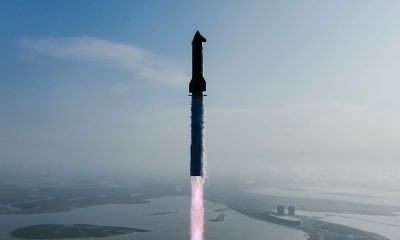

News
NASA aces most challenging Mars rover landing to date
After a nearly 300 million mile (480 million kilometer), seven-month-long journey, the world watched as NASA’s Mars 2020 Perseverance mission successfully completed the most challenging and precise landing the agency has ever attempted on Thursday (Feb. 18). Perseverance is NASA’s fifth rover and overall ninth mission to successfully land on the Red Planet.

On Thursday afternoon, the alien invader punched through the relatively thin Martian atmosphere streaking across the sky at a blazing 12,100 mph (19,500 kph). Then it shed a few layers, deployed the largest-ever supersonic parachute, and slowed down just enough to use a rocket-propelled crane to drop an autonomous, nuclear-powered, robotic astrobiologist called Perseverance on the surface of Mars.
Flawlessly completing the entry, descent, and landing sequence of its mission to land in Mars’ hostile Jezero Crater, NASA’s Mars 2020 Perseverance mission officially marked the completion of its interplanetary travel phase and began its mission to collect evidence of ancient, microbial Martian life.
Getting to Mars

On July 30, 2020, NASA’s Mars 2020 Perseverance mission launched aboard a United Launch Alliance Atlas V 541 rocket from Space Launch Complex 41 at Cape Canaveral Space Force Base. Aboard that rocket was NASA’s most ambitious Mars mission to date. The launch phase of the mission suffered a few minor delays ultimately shifting the launch date from July 18, 2020 to July 30, 2020. However, ULA’s Atlas V first stage rocket and Centaur upper stage delivered NASA’s Mars 2020 Perseverance mission into such an accurate trajectory that the 2,260 lb (1,025 kg) rover landed on its specified February 18 landing date despite the delays in the launch timeline.
In total, three missions to Mars – China’s Tianwen-1, the United Arab Emirates Hope Probe, and NASA’s Perseverance – left Earth in the summer of 2020. All three missions targeted to leave Earth prior to August to best take advantage of the minimal distance between the planets during what is called opposition. The opposition between Earth and Mars only occurs once every 22 months. If the Perseverance mission had missed its launch date it would’ve had to wait until 2022 for a chance to travel to the Red Planet.

Entry, Descent, and Landing – a controlled disassembly
As Perseverance descended into the Martian atmosphere the Cruise Phase – hardware that propelled the spacecraft through space for seven months – was jettisoned. The Perseverance rover safely tucked inside the aeroshell and protected by a robust heat shield soared through the thin Martian atmosphere enduring an extreme amount of friction that produced heat energy that reached up to 2,370 degrees Fahrenheit (about 1,300 degrees Celsius).
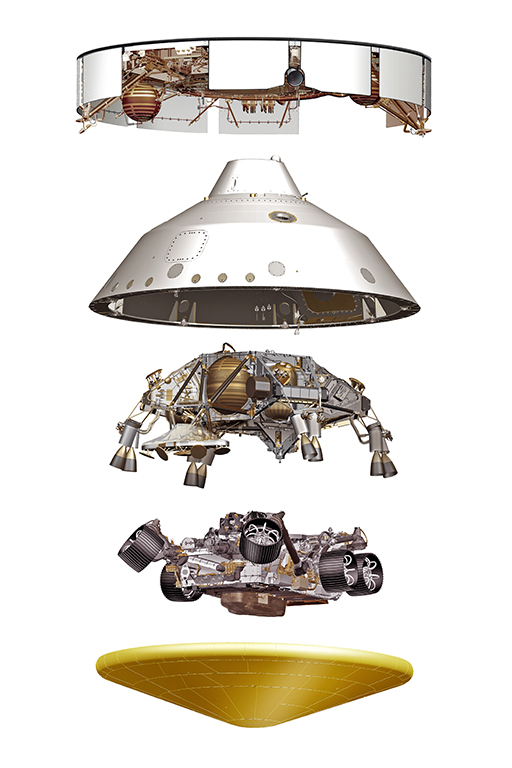
Once through the period of peak heating the heat shield was jettisoned exposing Perseverance to the Martian environment for the first time. Then about 7 miles (11 kilometers) from the surface the largest supersonic parachute NASA has ever sent to another planet – 70.5 feet (21.5 meters) in diameter – was deployed drastically slowing the spacecraft.
While still descending, the controlled descent module – called the sky crane – separated from the backshell about 1.3 miles (2.1 kilometers) above the surface to free-fly in the Martian atmosphere. The descent module used a new landing technology called Terrain-Relative Navigation used a constant stream of visual input and guidance collected from the Vision Compute Element and Rover Compute Element to determine the safest reachable landing site.

The throttleable rockets on the powered descent module steered the rover to its landing spot in Mars’ Jezero Crater and slowed to approximately 1.7 mph (2.7 kph) about 66 feet (20 meters) above the Martian surface. Perseverance was then lowered using a system of Nylon cords which were autonomously severed upon touchdown. The final stage of the controlled disassembly was for the sky crane to throttle its rockets back up and fly away for a crash landing a safe distance from the rover.
Ultimately, the Perseverance rover landed about a kilometer south of the intended delta of the Jezero Crater.
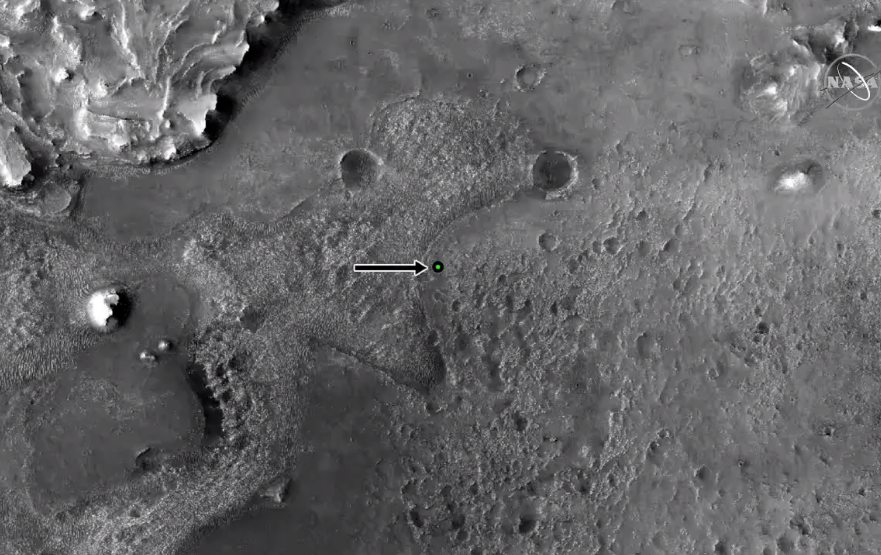
Perseverance made it to Mars, now what?
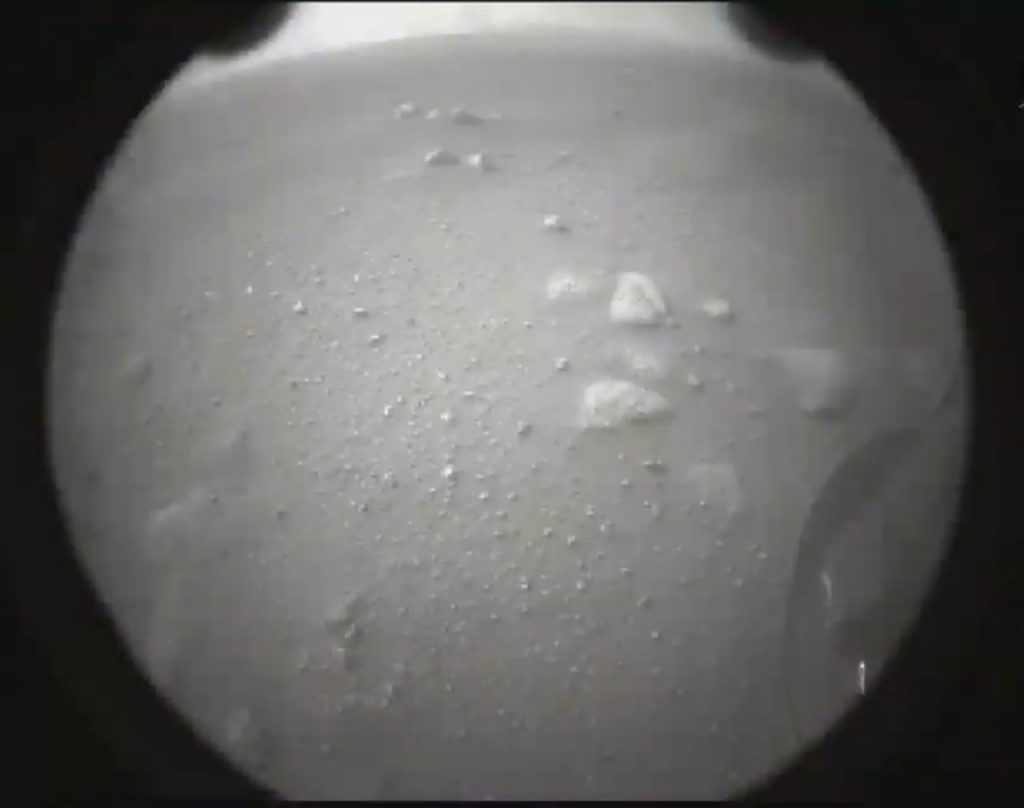
Getting to Mars was only the first of many milestones that Perseverance is expected to achieve during its projected one Mars year-long mission – about 687 Earth days. Now that the rover has touched down the science will begin.
First and foremost once Perseverance stretched its legs, so to speak, the first event took place just minutes after landing. Perseverance captured photos of the Martian surface with a pair of engineering cameras called Hazard Cameras mounted to the front and back of the rover.
The upgraded Navigation and Hazard cameras feature the capability to capture imagery of the Martian surface in 20 megapixel high-definition resolution for the first time. In the coming days, more images will be relayed back to Earth taken with the rover’s Navigation cameras and Mastcam-Z.

Once on Mars, the control of the Perseverance rover was transitioned from NASA JPL’s EDL team to the Perseverance Surface team. The Surface Phase of the Mars 2020 mission – or the phase of the mission that consists of the four main science objectives – began about twenty minutes after the touchdown.
Perseverance was sent to Mars to determine whether life ever existed on Mars, characterize the climate, characterize the geology, and prepare for the eventual human exploration of Mars. To achieve these massive science goals, the robotic astrobiologist was sent with an impressive suite of scientific research tools. Over the next 30 Martian days – called sols – the rover will begin to unfurl and begin testing the various pieces of hardware in preparation for exploring the delta of Jezero Crater.
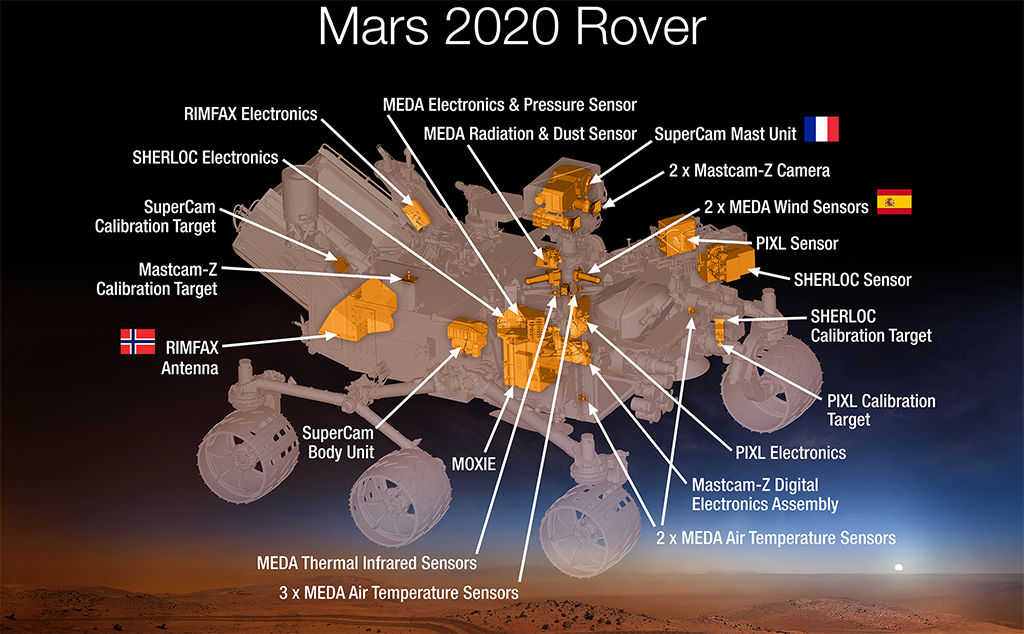
Deploying the stowaway
Perseverance not only took a roving science lab to Mars, but it also took the first rotorcraft helicopter to be deployed to another planet dubbed Ingenuity. Ingenuity is a small double-bladed rotorcraft weighing only about 4 pounds (1.8 kilograms).
After the initial 30 Ssls of stretching its legs, Perseverance will travel a short distance to find a flat area of the Martian surface to deploy the Ingenuity helicopter. Once deployed, the Ingenuity team will have a technology demonstration window of approximately 30 sols to complete the first flight test of Ingenuity – the first time powered, controlled flight will be attempted on another planet.
Landing is just the beginning

As exciting as landing on Mars was, it is only the beginning for the Mars 2020 Perseverance rover. The nuclear-powered astrobiology robot will spend the next Martian year excavating the surface of a very rich delta in the Jezero crater searching for the first evidence of ancient, microbial life.
Even more exciting is that Perseverance is only the first phase of a larger mission called the Mars Sample Return mission that will someday bring the excavated samples that Perseverance collects back to Earth in a joint effort between NASA and the European Space Agency.
Although the Perseverance mission is only intended to last one Martian year, Perseverance has the capacity to extend its mission to nearly 15 years thanks to its power source, a Multi-Mission Radioisotope Thermoelectric Generator (MMRTG) which produces a steady stream of electricity provided by the radioactive decay of plutonium-238. Perseverance could potentially outlast all of NASA’s other Mars missions.
News
Tesla UK sales see 14% year-over-year rebound in June: SMMT data
The SMMT stated that Tesla sales grew 14% year-over-year to 7,719 units in June 2025.

Tesla’s sales in the United Kingdom rose in June, climbing 14% year-over-year to 7,719 units, as per data from the Society of Motor Manufacturers and Traders (SMMT). The spike in the company’s sales coincided with the first deliveries of the updated Model Y last month.
Model Y deliveries support Tesla’s UK recovery
Tesla’s June performance marked one of its strongest months in the UK so far this year, with new Model Y deliveries contributing significantly to the company’s momentum.
While the SMMT listed Tesla with 7,719 deliveries in June, independent data from New AutoMotive suggested that the electric vehicle maker registered 7,891 units during the month instead. However, year-to-date figures for Tesla remain 2% down compared to 2024, as per a report from Reuters.
While Tesla made a strong showing in June, rivals are also growing. Chinese automaker BYD saw UK sales rise nearly fourfold to 2,498 units, while Ford posted the highest EV growth among major automakers, with a more than fourfold increase in the first half of 2025.
Overall, the UK’s battery electric vehicle (BEV) demand surged 39% to to 47,354 units last month, helping push total new car sales in the UK to 191,316 units, up 6.7% from the same period in 2024.
EV adoption accelerates, but concerns linger
June marked the best month for UK car sales since 2019, though the SMMT cautioned that growth in the electric vehicle sector remains heavily dependent on discounting and support programs. Still, one in four new vehicle buyers in June chose a battery electric vehicle.
SMMT Chief Executive Mike Hawes noted that despite strong BEV demand, sales levels are still below regulatory targets. “Further growth in sales, and the sector will rely on increased and improved charging facilities to boost mainstream electric vehicle adoption,” Hawes stated.
Also taking effect this week was a new US-UK trade deal, which lowers tariffs on UK car exports to the United States from 27.5% to 10%. The agreement could benefit UK-based EV producers aiming to expand across the country.
News
Tesla Model 3 ranks as the safest new car in Europe for 2025, per Euro NCAP tests
Despite being on the market longer than many of its rivals, the Tesla Model 3 continues to set the bar for vehicle safety.

The Tesla Model 3 has been named the safest new car on sale in 2025, according to the latest results from the Euro NCAP. Among 20 newly tested vehicles, the Model 3 emerged at the top of the list, scoring an impressive 359 out of 400 possible points across all major safety categories.
Tesla Model 3’s safety systems
Despite being on the market longer than many of its rivals, the Tesla Model 3 continues to set the bar for vehicle safety. Under Euro NCAP’s stricter 2025 testing protocols, the electric sedan earned 90% for adult occupant protection, 93% for child occupant protection, 89% for pedestrian protection, and 87% for its Safety Assist systems.
The updated Model 3 received particular praise for its advanced driver assistance features, including Tesla’s autonomous emergency braking (AEB) system, which performed well across various test scenarios. Its Intelligent Speed Assistance and child presence detection system were cited as noteworthy features as well, as per a WhatCar report.
Other notable safety features include the Model 3’s pedestrian-friendly pop-up hood and robust crash protection for both front and side collisions. Euro NCAP also highlighted the Model 3’s ability to detect vulnerable road users during complex maneuvers, such as turning across oncoming traffic.
Euro NCAP’s Autopilot caution
While the Model 3’s safety scores were impressive across the board, Euro NCAP did raise concerns about driver expectations of Tesla’s Autopilot system. The organization warned that some owners may overestimate the system’s capabilities, potentially leading to misuse or inattention behind the wheel. Even so, the Model 3 remained the highest-scoring vehicle tested under Euro NCAP’s updated criteria this year.
The Euro NCAP’s concerns are also quite interesting because Tesla’s Full Self-Driving (FSD) Supervised, which is arguably the company’s most robust safety suite, is not allowed for public rollout in Europe yet. FSD Supervised would allow the Model 3 to navigate inner city streets with only minimal human supervision.
Other top scorers included the Volkswagen ID.7, Polestar 3, and Geely EX5, but none matched the Model 3’s total score or consistency across categories. A total of 14 out of 20 newly tested cars earned five stars, while several models, including the Kia EV3, MG ZS, and Renault 5, fell short of the top rating.
Elon Musk
Why Tesla’s Q3 could be one of its biggest quarters in history
Tesla could stand to benefit from the removal of the $7,500 EV tax credit at the end of Q3.

Tesla has gotten off to a slow start in 2025, as the first half of the year has not been one to remember from a delivery perspective.
However, Q3 could end up being one of the best the company has had in history, with the United States potentially being a major contributor to what might reverse a slow start to the year.
Earlier today, the United States’ House of Representatives officially passed President Trump’s “Big Beautiful Bill,” after it made its way through the Senate earlier this week. The bill will head to President Trump, as he looks to sign it before his July 4 deadline.
The Bill will effectively bring closure to the $7,500 EV tax credit, which will end on September 30, 2025. This means, over the next three months in the United States, those who are looking to buy an EV will have their last chance to take advantage of the credit. EVs will then be, for most people, $7,500 more expensive, in essence.
The tax credit is available to any single filer who makes under $150,000 per year, $225,000 a year to a head of household, and $300,000 to couples filing jointly.
Ending the tax credit was expected with the Trump administration, as his policies have leaned significantly toward reliance on fossil fuels, ending what he calls an “EV mandate.” He has used this phrase several times in disagreements with Tesla CEO Elon Musk.
Nevertheless, those who have been on the fence about buying a Tesla, or any EV, for that matter, will have some decisions to make in the next three months. While all companies will stand to benefit from this time crunch, Tesla could be the true winner because of its sheer volume.
If things are done correctly, meaning if Tesla can also offer incentives like 0% APR, special pricing on leasing or financing, or other advantages (like free Red, White, and Blue for a short period of time in celebration of Independence Day), it could see some real volume in sales this quarter.
You can now buy a Tesla in Red, White, and Blue for free until July 14 https://t.co/iAwhaRFOH0
— TESLARATI (@Teslarati) July 3, 2025
Tesla is just a shade under 721,000 deliveries for the year, so it’s on pace for roughly 1.4 million for 2025. This would be a decrease from the 1.8 million cars it delivered in each of the last two years. Traditionally, the second half of the year has produced Tesla’s strongest quarters. Its top three quarters in terms of deliveries are Q4 2024 with 495,570 vehicles, Q4 2023 with 484,507 vehicles, and Q3 2024 with 462,890 vehicles.
-

 Elon Musk4 days ago
Elon Musk4 days agoTesla investors will be shocked by Jim Cramer’s latest assessment
-

 News1 week ago
News1 week agoTesla Robotaxi’s biggest challenge seems to be this one thing
-

 Elon Musk2 weeks ago
Elon Musk2 weeks agoFirst Look at Tesla’s Robotaxi App: features, design, and more
-

 News2 weeks ago
News2 weeks agoSpaceX and Elon Musk share insights on Starship Ship 36’s RUD
-

 News2 weeks ago
News2 weeks agoWatch Tesla’s first driverless public Robotaxi rides in Texas
-

 News1 week ago
News1 week agoWatch the first true Tesla Robotaxi intervention by safety monitor
-

 News2 weeks ago
News2 weeks agoTesla has started rolling out initial round of Robotaxi invites
-

 Elon Musk2 weeks ago
Elon Musk2 weeks agoTesla to launch in India in July with vehicles already arriving: report











